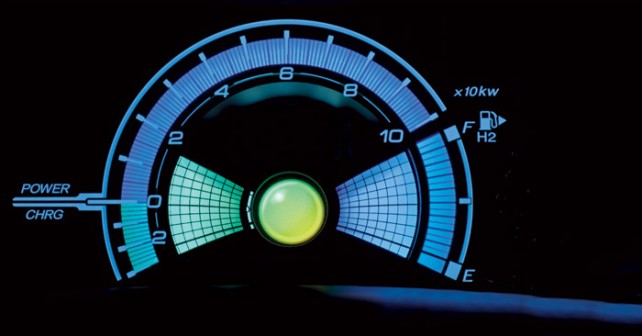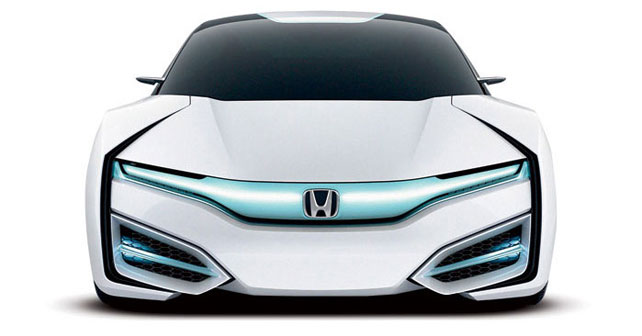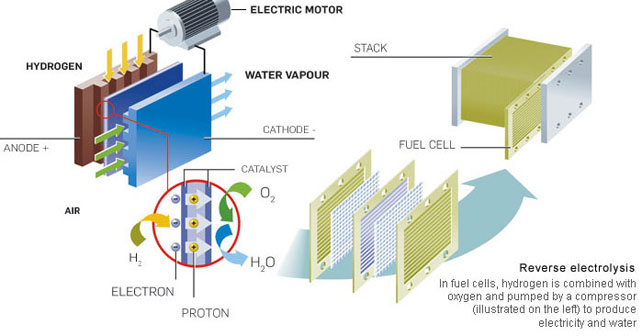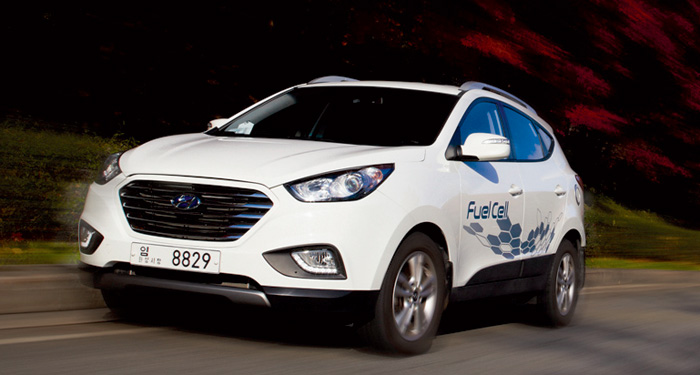Later this year, Hyundai will lease out fuel cell cars in the US – followed next year by Honda and Toyota. After a bunch of inflated announcements, could this finally be the chance for the hydrogen fuel cell to take off?
For fuel cell cars, 2013 ended with a bang. These are electric cars whose batteries aren’t recharged by plugging into the electricity grid network – they instead fill up on hydrogen, which is then transformed into power through a chemical process (refer to the box on pg.111). And they’ve come back with a vengeance. Following the innumerable proclaimed agreements and joint technical ventures that were signed during the summer months, 2013 came to a close with no fewer than three product announcements – two prototypes that are ready to be commercialized by 2015, and a standard model ready to be made available on lease in the spring, although only in a geographically limited area. So, is this the latest false promise – the latest bombastic advertisement (we’ve collected some previous ones in the following pages), or a turning point on the ground-breaking path leading to zero-pollution mobility? Leaving aside the sensible scepticism, let’s run through the developments of what, if the promises are kept, could become a year of wonder for cell and battery-powered cars.
Ready for the market
At the end of November, the Tokyo and Los Angeles motor shows will share the spotlight of the eco-auto world – with the Toyota FCV Concept in Japan and the Honda FCEV Concept in the US. Meanwhile, Hyundai has shown its cards – the ix35 / Tucson FC, which, last summer, led a series of joint initiatives with municipalities from different European capitals, from London to Copenhagen. It’ll be offered to begin with to private clients in Southern California starting next spring. The three-year contract stipulates a $3,000 deposit and a $500 monthly fee, which includes the rental of the SUV, unlimited supply of hydrogen, and a valet service for any required maintenance and repair work (along with a temporary replacement car). From the City of the Angels, which confirms its commitment to sustainability, the initiative should spread through the whole of the state of California. Hyundai highlights, however, that everything depends on the development of its hydrogen distribution network (see box on pg. 115). Covering nearly 600 kilometres on a full tank of hydrogen, the fuel cell SUV provides a convincing answer to one of the yet unresolved problems plaguing lithium ion batteries – range. Moreover, the refuelling times of a hydrogen fuel cells are decidedly lower than those required by an electric recharge. They’re also looking for solutions to other criticisms they’ve been subjected to, such as the safe stowage of hydrogen on board, and the size of cell packs. Because, though the lay person might have thought that fuel cells have gone into hibernation, in the secret basements of auto companies R&D departments, the experiments never stopped.
Ready for 2015
This is how, for example, the Honda FCEV Concept (leading the display at the Los Angeles show) wraps, within its aerodynamic form, a fuel cell stack – which, compared to the 2007 FCX Clarity, has increased its energy density by 60%, thereby reducing physical size by a third. As a result, it can now be installed in front – in place of the conventional engine, rather than vertically behind the dashboard as with the Clarity. The advantage of this is that it does not impose the limitations of a fixed architecture, and, instead, allows itself to being adapted freely – even for an existing product. Moreover, the prototype that preceded the standard model (expected in the Japanese and American markets next year) is refilled with hydrogen every 500 kilometres in less than 3 minutes. The FCEV counts on Honda’s subject expertise. It’s been one of the most involved automakers in the hydrogen sector since the start of the third millennium. In 2005, the FCX was the first fuel cell car to be sold to a private entity. In 2008, its production line of the Clarity was the first specific production line for fuel cell cars.
Toyota, the undisputed leader of hybrid cars, refuses to watch from the sidelines. Sceptical about the proximity of a historical jump in the evolution of lithium-powered batteries (in terms of energy density and recharge time), the Japanese colossus sees fuel cells powering cars in any season, and, above all, over any distance. The FCV Concept, presented in Tokyo, claims a range of 500 kilometres. Compared to the 2008 FCHV-adv, the energy density has practically doubled and total power touches 100kW (136bhp). Moreover, Toyota has been able to reduce engine size and the number of fuel cells. The system, therefore, is now more compact and can be stored underneath the car’s floor, leaving space in the passenger area for four people.
A handy miracle
In terms of style, the Japanese designers claim to have drawn inspiration from the image of air that transforms itself into water, which is indeed the miracle that happens in a fuel cell (see pg.111). It’s a miracle that is scientifically verifiable and reproducible, and, what’s more, comes at massively reduced costs. The US energy department’s expectations, according to Toyota, need to be lowered. Japanese technicians say that today the economic effort is 10 times lower than it was for the 2007 prototype – and by the time the first sedan gets introduced by 2015, those projections should be reduced even more. The FCV should, therefore, cost somewhere around 75 thousand Euros and then drop once quantity rises, preferably into the thousands of units.
Between optimism and caution
So, everything’s sorted then? Will 2020 be the turning point – will it see exhaust emissions of fossil fuel cars progressively, but unstoppably, replaced by graceful and imperceptible droplets of water? According to Soichiro Okudaira, head of Toyota’s R&D team, the answer is a yes – although it won’t be until the next decade that the process of reducing the weight and encumbrance of fuel cells will be completed. By this time, the necessary Hydrogen infrastructure will also be fully developed. And this is the real issue, because however much automotive technology may be capable of improving itself, without a hydrogen production and distribution network the announced revolution is destined to remain a utopia.
Toyota FCV CONCEPT
At the end of November 2013, Toyota unveiled a fuel cell car, which should hit Japanese dealerships in 2015 and the American ones a year later
Honda FCEV CONCEPT
In 2015, the standard model of the prototype showcased in Los Angeles will be introduced in the US, and, shortly thereafter, in Europe
Hyundai ix35 FC
Tucscon, Arizona, will be the first metropolitan area where private customers will be able to lease a hydrogen-powered ix35
Futuristic
A decidedly futuristic look for the Honda FCEV, which announces the Japanese automaker’s new generation of fuel cell cars. Among the most significant innovations – a one-third reduction of the fuel stack size
Reverse electrolysis
In fuel cells, hydrogen is combined with oxygen and pumped by a compressor (illustrated on the left) to produce electricity and water
How They Work
ALTERNATIVE TO LITHIUM BATTERIES
Refuelling times
Shorter recharging time and greater range (in excess of 500 kilometres on a full tank of hydrogen): here’s why the fuel cell cars represent a valid alternative to lithium batteries.
The hydrogen contained in the tank, and the oxygen present in the atmosphere (pumped in by a compressor), react with each other producing electric energy and water. This is the reverse phenomenon of electrolysis (in which electric energy is used to divide the water into the two gases). The most well-known fuel cells, called PEM, are those with a ‘proton-exchange membrane.’ In these, hydrogen splits into protons and electrons on the anode: the protons are able to pass through the special polymeric membrane in order to reach the cathode (where they react to the oxygen), while the electrons are forced to transit through an external circuit in order to reach the cathode and reassemble – thus producing electrical energy. Usually the catalyst present on electrodes is platinum, which is one of the causes of the fuel cell’s high price. The electrochemical transformation is accompanied by the generation of heat. Therefore, in order to keep the temperature in the battery constant it has to be provided a cooling circuit.
A single cell normally produces a voltage of approximately 0.7V and currents of between 400 and 800mA/cm2: in order to acquire the desired power and voltage, more cells are arranged in a series in order to form a stack. The stacks, in turn, are assembled in modules in order to obtain generators emitting the necessary amount of power. Hydrogen doesn’t exist freely in nature: it needs to be produced and to do so requires energy. And more energy is needed to liquefy it (stowing it at -253 °C) or alternatively to compress it in gaseous form in tanks at pressures of 350 or 700bar (methanol is at 200). The storage of a sufficient quantity of hydrogen on board can also happen by exploiting the metal hydrides that retain and release gas like sponges or, alternatively, by resorting to nanotechnology. Other issues worth considering regard the robustness of cells in extreme conditions along with their lifecycles and acceleration response times. E.B.
Behind the Toyota FCV
IT PUSHES HARD AND BLOWS LIKE A TURBO
The ‘mule’ for the upcoming Toyota FCV is a midsized five-door hybrid Lexus HS. The trial ground is the Aisin circuit at Fukuoka, twenty or so kilometres from Toyota City. This is enough to gather that the whole of the concept holds up and that the progress made over previous prototypes (such as the FCHV-4) is significant. Let’s start with the packaging – if six years ago it might have needed a mega-SUV body, today it fits under the skin of a sedan. The clutter of the hydrogen tanks (two carbon-reinforced gas tanks are compressed to 70MPa), is reduced by half, as are those fuel cells that guarantee a specific power of 3kW/l. And though the useful space on board of the HS suffers a bit from the change (particularly the luggage compartment), the ‘true’ FCV promises to make considerable improvements. At the slightest throttle application, you feel the buzz produced by the hydrogen pump while acceleration is accompanied by a marked ‘turbo-style’ puff coming from the exhaust. The response during acceleration is consistent, though perhaps not as immediate as on the purely electric cars – at at a guess, a kilometre should easily suffice to reach speeds of up to 150km/h. The travel of the throttle pedal is quite extended even if, in practice, the command’s response is very similar to an ‘on-off’ switch. The Toyota technicians divulge nothing, but there certainly are a few extra hundred kilos of weight to drag along – you can tell by the inertia that accompanies rapid direction changes. On release, the car conserves a fluidity not entirely dissimilar to the normal electrical cars – the effect produced by the energy recovery is evident only when braking, with the usual ‘metallic’ response (like electric cars) produced by the pedal. M.N.
Beyond the Prius
The Toyota FCV Concept – it’s 4,870mm long and 1,530mm tall. In the representation on the side, you can see one of the two hydrogen tanks. Above is the prototype on trial on the Fukuoka circuit
Equal, but...
The Hyundai ix35 FC is a compact SUV that we all know, but to propel it there’s an engine inducing 136bhp and 300Nm. The fuel cells are powered by hydrogen contained in two 700-bar tanks installed in the centre of the car. Max speed hits 160km/h and the range is 594km
GLOSSARY
ENERGY DENSITY
Energy quantity stored in a given system by units of volume (kW/l).
ELECTROLYSIS
Process of splitting water into hydrogen and oxygen by way of electrical current.
REVERSE ELECTROLYSIS
The opposite of the previous process: hydrogen and oxygen assemble to generate electricity and water.
PEM
Proton exchange membrane –a very unique sort of plastic sheet that works as an electrolyte within the fuel cell.
REFORMER
Device that extracts hydrogen from conventional fuel (methanol, usually).
STACK
In a stack, different fuel cells are linked in a series. The stacks, in turn, are united in modules to produce a generator that meets the power requirements of the vehicle.
Issues to resolve
SLOW GOING
The hydrogen distribution network, though in the phase of expansion, remains embryonic. This without even mentioning that gas continues to be produced by non-renewable sources…
Of the 208 hydrogen refuelling stations that exist in the world (data from March 2013), 80 of them are in Europe. Of these, 33 are in Germany thanks in particular to the experimentation started at the time by BMW on the hydrogen combustion engine supply (later abandoned). Of the 76 hydrogen pumps in North America, nine are in California, which is expecting another hundred within the coming year. The Japanese network is also growing. Latin America is at the tail end with only 3 total distributors. In other words, we’re not starting from scratch, but the road ahead is long. It’s obvious then that the development of the network is a fundamental precondition for the technical collaboration agreements entered into in 2013 (BMW and Toyota; GM and Honda; Daimler, Ford and Renault-Nissan). The proliferation of hydrogen pumps is not, however, the only issue weighing on the fuel cell’s future. Even when presuming an orderly expansion from certain auto manufacturers, fuel cell technology will exercise influence on the global energy balance only if and when hydrogen itself is produced from renewable sources. Otherwise, as is the case with strictly electric cars, the pollution would merely be moved upstream.
IT ALL STARTED IN THE 1700’S

Henry Cavendish, Scottish chemist and physician, discovers hydrogen as an independent element.

William Grove, Scottish chemist, invents the gas voltaic battery, which mixes hydrogen and oxygen to obtain electricity and water.
1889
The Grove’s intuition is developed experimentally by Brits Ludwig Mond and Carl Langer, who baptize it as the fuel cell.

NASA uses the fuel cell in space mission Gemini 7. In 1970, it was the explosion of an oxygen tank that caused the Apollo 13 ‘problem’

General Motors introduces the Electrovan Fuel Cell

As with the GM Electrovan, the first Necar (New electric car ) Daimler system fuel cell also occupies the entire loading compartment of a van.
1996
Nissan works on a FCV with a methanol fuelled reformer. Toyota introduces the FCEV. Daimler unveils the Necar 2, made on the basis of the minivan Class V (the Necar 1 used a commercial vehicle).

Chrysler ad: a fuel cell car will be produced on an industrial scale at some point between 2006-2007. The Daimler Necar 3, based on the A-Class (photo) and the Mazda Demio FC- EV in methanol are both released.
1998
At the Paris Motor Show, two concept cars based on the Opel Zafira make their debut: a methanol fuelled reformer, the other (HydroGen1) uses liquefied hydrogen (75 litre tank at -253 °C, 400km of range). The brand claims commercialisation of both is possible by 2004.
1999
General Motors and Toyota sign a five-year agreement, which includes tests on fuel cell cars. At the Tokyo Motor Show, Honda presents the prototype FCX- V1, with a metal hydride tank, and FCX -V2, with a methanol fuelled reformer. The arrival of the Daimler Necar 4 (based on the A-Class) on the market is scheduled for 2003.
THIRD-MILLENIUM ENTHUSIASM
2000
Ford Focus FCV, GM Precept FCEV concept, Honda FXC-V3, Jeep Commander II, Daimler Necar 5 (released in 2004), VW Bora Hy-motion. BMW decides that it is not interested in fuel cell cars (it only wants to use the technology for on-board services).

Honda FCX-V4 (liquid hydrogen, 180km range), Toyota FCHV-4 (high-pressure tank, road tested in Japan and the US), Hyundai Santa Fe FCEV (160km range), Mazda Premacy FC-EV, Opel HydroGen3 (photo), Peugeot Partner Hydro-gen (30kW fuel cell and 140 litres of hydrogen in 350-bar cylinders).

GM Hy-Wire (fuel cell and by-wire, to be released by 2013), Honda FCX, Mercedes F-Cell (still based on the A-Class), Nissan X-Trail FCHV (photo), VW Bora Hy-power. Agreement reached between GM and Suzuki on the joint development of fuel cells for small cars.
2003
Jeep Treo-Fuel cell, Fiat Seicento Hydrogen, Toyota Fine-S and Fine-T concepts. GM declares: “In the next ten years, we will have made 100,000 fuel cell cars; and in the next 30 years, one car out of two will be hydrogen-powered.”
2004
Audi A2H2, Mitsubishi FCV, Peugeot Quark, VW Touran Hy-motion. After a billion dollars of investments, GM intends to sell a million fuel cell cars by 2010. The Honda FCX costs approximately a million euros. The Opel Fuel Cell Marathon travels 9,696 kilometres in 14 different European countries – double that of the previous record (Daimler-Chrysler in 2002). The European commission releases Lighthouse, a ten-year program designed to stimulate fuel cell technology along with the refuelling network. In Germany and the United States the first hydrogen distributors are opened (liquid and gas).

Fiat Panda Hydrogen, Mercedes F600 Hygenius, Toyota Fine-T and Fine-X. The Sequel Concept Chevrolet ‘brings the ideas of sustainable mobility and standardized production much closer together.’ Honda delivers the first FCX to a private client: the Spallino family from Los Angeles (photo).

In the B-Class F-Cell, Mercedes utilizes nearly 100 grams of platinum – it intends to scale that down to 10, thanks to nanotechnologies. Hyundai makes a million-dollar Tucson FCV. Chevrolet introduces the concept Equinox (photo) while Peugeot releases the 207 Epure.
TECHNOLOGY IN PROGRESS

Fuel Cell Chevrolet Volt, GM HydroGen4 and Hummer 02 fuel cell (expected in the market by 2015), Honda FCX Clarity (photo) on a three-year lease at $600 a month, Hyundai i-Blue FCEV on an i30 base, VW space up! Blue. Renault announces that in 2010 it will begin to produce fuel cell cars in India. Nick Cappa, head of Daimler-Chrysler’s advanced technologies team predicts that from 2012 to 2015 there will be as many fuel cell cars being sold as there were hybrid cars in 2007.
2008
Fiat Phyllis, Fioravanti Hidra, Peugeot H20rigin, Pininfarina Sintesi, Renault Scenic ZEV H2 (in collaboration with Nissan), Suzuki SX-4 fuel cell, Toyota FCHV-adv. GM announces that before 2012 there will be at least a thousand fuel cell cars driving on Californian streets. According to the president of Mercedes, Dieter Zetsche, between 2014-2015 the B-Class F-Cell could sell 100,000 units a year. Tsutomu Matsuoka (Mazda R&D) declares that in 2020 fuel cell cars will be ‘a normal product.’

Aston Martin Volare Concept (two-seater with the stack between seats), Audi Q5 HFC (photo), Kia Borrego FCEV (10,000 units by 2015). Mercedes B-Class and F-Cell Roadster. Ford leaves fuel cell technology to its hybrid and electric cars. BMW drops the hydrogen combustion engine in favour of fuel cell cars.

Hyundai Blue2 concept, Toyota FCV-R (photo). The Japanese manufacturer signs an agreement with BMW. The EU regulates the ratification of hydrogen cars. After 30,000km around the world, the F-Cell World Drive comes to an end (photo).
2012
Hyundai announces the production version of the ix35/Tucson FC with the objective of making at least a 1,000 units by 2015. Toyota says it wants to release a fuel cell version of the Prius.

In the summer, BMW and Toyota on one side, and Honda and GM (photo) on the other, sign joint technical ventures for the development of fuel cell technology. There are agreements between Daimler, Ford and Renault-Nissan. VW runs its first tests on a fuel cell A7. In December, Hyundai announces the Intrado, a hydrogen electric concept car to be unveiled at the Geneva Show.
© Riproduzione riservata


































Write your Comment